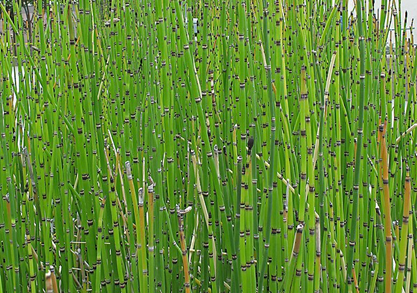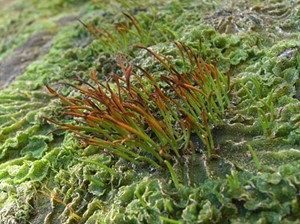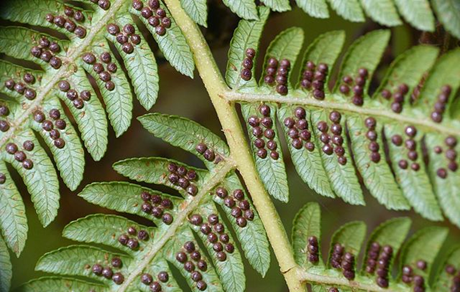13 The Non-Vascular Plants and Seedless Vascular Plants
By the end of this chapter you will be able to:
- Describe the distinguishing traits of the three types of bryophytes
- Identify the new traits that first appear in seedless vascular plants
- Describe the major classes of seedless vascular plants
- Compare and contrast roots, rhizoids, and mycorrhizae
Introduction
An incredible variety of seedless plants populates the terrestrial landscape from liverworts, mosses, hornworts, club mosses and ferns (Fig 1).

Figure 1: The different groups of plants found today. Notice that the seedless plants begin with the liverworts as the oldest, most primitive group of land plants and the ferns are the most advanced seedless group. The ferns do have vascular tissue, whereas the older groups to the left do not have this tissue. Laurenprue216, via Wikimedia Commons
Mosses grow on tree trunks, and horsetails (Fig 2) display their jointed stems and spindly leaves on the forest floor. Yet, seedless plants represent only a small fraction of the plants in our environment. Three hundred million years ago, seedless plants dominated the landscape and grew in the enormous swampy forests of the Carboniferous period. Their decomposing bodies created large deposits of coal that we mine today.

Figure 2: Seedless plants like these horsetails (Equisetum sp.) thrive in damp, shaded environments under the tree canopy where dryness is a rare occurrence. Downtowngal, via Wikimedia Commons
Bryophytes
Bryophytes, an informal grouping of the nonvascular plants, are the closest extant relative of early terrestrial plants. The first bryophytes most probably appeared in the Ordovician period, about 490 million years ago. Because of the lack of lignin—the tough polymer in cell walls in the stems of vascular plants—and other resistant structures, the likelihood of bryophytes forming fossils is rather small, though some spores made up of sporopollenin have been discovered that have been attributed to early bryophytes. By the Silurian period (440 million years ago), however, vascular plants had spread throughout the continents. This fact is used as evidence that nonvascular plants must have preceded the Silurian period.
There are about 18,000 species of bryophytes, which thrive mostly in damp habitats, although some grow in deserts. They constitute the major flora of inhospitable environments like the tundra, where their small size and tolerance to desiccation offer distinct advantages. They do not have the specialized cells that conduct fluids found in the vascular plants, and generally lack lignin. In bryophytes, water and nutrients circulate inside specialized conducting cells. Although the name non-tracheophyte is more accurate, bryophytes are commonly referred to as non-vascular plants.
In a bryophyte, all the conspicuous vegetative organs belong to the haploid organism, or gametophyte. The diploid sporophyte is barely noticeable. The gametes formed by bryophytes swim using flagella. The sporangium, the multicellular sexual reproductive structure, is present in bryophytes. The embryo also remains attached to the parent plant, which nourishes it. This is a characteristic of land plants.
The bryophytes are divided into three divisions (in plants, the taxonomic level “division” is used instead of phylum): the liverworts, or Marchantiophyta; the hornworts, or Anthocerotophyta; and the mosses, or true Bryophyta (Fig 3).

Figure 3: The three divisions of bryophtes. EncycloPetey, via Wikimedia Commons
Liverworts
Liverworts (Marchantiophyta) may be viewed as the plants most closely related to the ancestor that moved to land. Liverworts have colonized many habitats on Earth and diversified to more than 6,000 existing species (Fig 4a). Some gametophytes form lobate green structures (Fig 4b). The shape is similar to the lobes of the liver and, hence, provides the origin of the common name given to the division.

Figure 4: (a) A 1904 drawing of liverworts shows the variety of their forms. (b) A liverwort, Lunularia cruciata, displays its lobate, flat thallus. The organism in the photograph is in the gametophyte stage.
Hornworts
The hornworts (Anthocerotophyta) have colonized a variety of habitats on land, although they are never far from a source of moisture. There are about 100 described species of hornworts. The dominant phase of the life cycle of hornworts is the short, blue-green gametophyte. The sporophyte is the defining characteristic of the group. It is a long and narrow pipe-like structure that emerges from the parent gametophyte and maintains growth throughout the life of the plant (Fig 5).

Figure 5: Hornworts grow a tall and slender sporophyte. (credit: modification of work by Jason Hollinger)
Mosses
More than 12,000 species of mosses have been cataloged. Their habitats vary from the tundra, where they are the main vegetation, to the understory of tropical forests. In the tundra, their shallow rhizoids allow them to fasten to a substrate without digging into the frozen soil. They slow down erosion, store moisture and soil nutrients, and provide shelter for small animals and food for larger herbivores, such as the musk ox. Mosses are very sensitive to air pollution and are used to monitor the quality of air. The sensitivity of mosses to copper salts makes these salts a common ingredient of compounds marketed to eliminate mosses in lawns (Fig 6).

Figure 6: This green feathery moss has reddish-brown sporophytes growing upward. (credit: “Lordgrunt”/Wikimedia Commons)
Because they are the most common of the bryophytes, we will discuss their traits in more detail. Mosses are simple, non-vascular plants, like all bryophytes, which means they lack specialized tissues for transporting water and nutrients. Some key features of mosses include:
- As mentioned above, mosses do not have true roots, stems, or leaves with specialized vascular tissues like xylem and phloem. Instead, they have simple structures that serve similar functions, but without the same level of complexity. For example, they have small, leaf-like structures known as phyllids or gametophylls. These structures are often one cell layer thick and lack the internal structures found in true leaves.
- Mosses anchor themselves to surfaces with thread-like structures called rhizoids. Rhizoids help with attachment and water absorption but are not true roots.
- Mosses primarily absorb water through their entire plant body, as they lack specialized root systems. They can absorb moisture from rain, dew, or moist soi and rely on diffuse to get water from the soil into their body.
- Mosses reproduce through spores produced in capsules found on the tips of stalks. They do not produce seeds or flowers like higher plants.
Vascular Seedless Plants
The vascular plants are the dominant and most conspicuous group of land plants. There are about 275,000 species of vascular plants, which represent more than 90 percent of Earth’s vegetation. Several evolutionary innovations explain their success and their spread to so many habitats.
The first fossils that show the presence of vascular tissue are dated to the Silurian period, about 430 million years ago. The simplest arrangement of conductive cells shows a pattern of xylem at the center surrounded by phloem. Xylem is the tissue responsible for long-distance transport of water and minerals, the transfer of water-soluble growth factors from the organs of synthesis to the target organs, and storage of water and nutrients.
A second type of vascular tissue is phloem, which transports sugars, proteins, and other solutes through the plant. Phloem cells are divided into sieve elements, or conducting cells, and supportive tissue. Together, xylem and phloem tissues form the vascular system of plants. Often, material, such as nutrients and water, that is transported throughout the plant must be first moved into the plant from the soil through the roots.
Roots are not well preserved in the fossil record; nevertheless, it seems that they did appear later in evolution than vascular tissue. The development of an extensive network of roots represented a significant new feature of vascular plants. Thin rhizoids attached the bryophytes to the substrate. Their rather flimsy filaments did not provide a strong anchor for the plant; neither did they absorb water and nutrients. In contrast, roots, with their prominent vascular tissue system, transfer water and minerals from the soil to the rest of the plant. The extensive network of roots that penetrates deep in the ground to reach sources of water also stabilizes trees by acting as ballast and an anchor. The majority of roots establish a symbiotic relationship with fungi, forming mycorrhizae. In the mycorrhizae, fungal hyphae grow around the root and within the root around the cells, and in some instances within the cells. This benefits the plant by greatly increasing the surface area for absorption.
A third adaptation marks seedless vascular plants. Accompanying the prominence of the sporophyte and the development of vascular tissue, the appearance of true leaves improved photosynthetic efficiency. Leaves capture more sunlight with their increased surface area.
In addition to photosynthesis, leaves play another role in the life of the plants. Pinecones, mature fronds of ferns, and flowers are all sporophylls—leaves that were modified structurally to bear sporangia. Strobili are structures that contain the sporangia. They are prominent in conifers and are known commonly as cones: for example, the pinecones of pine trees.
By the Late Devonian period (385 million years ago), plants had evolved vascular tissue, well-defined leaves, and root systems. With these advantages, plants increased in height and size. During the Carboniferous period (359–299 million years ago), swamp forests of club mosses and horsetails, with some specimens reaching more than 30 meters tall, covered most of the land (Fig 7). These forests gave rise to the extensive coal deposits that gave the Carboniferous its name. In seedless vascular plants, the sporophyte became the dominant phase of the lifecycle.

Figure 7: Plants of the Carboniferous age. Club mosses grew tall in height and the frond leaf was commonplace. Bibliographisches Institut, Public domain, via Wikimedia Commons
Water is still required for the fertilization of seedless vascular plants as there are still sperm cells present with flagella tails that need to move through water, and most favor a moist environment. Modern-day seedless vascular plants include club mosses, horsetails, ferns, and whisk ferns.
Club Mosses
The club mosses, or Lycophyta, are the earliest group of seedless vascular plants. They dominated the landscape of the Carboniferous period, growing into tall trees and forming large swamp forests (Fig 8). Today’s club mosses are diminutive, evergreen plants consisting of a stem (which may be branched) and small leaves called microphylls (Fig 8). The division Lycophyta consists of close to 1,000 species, including quillworts (Isoetales), club mosses (Lycopodiales), and spike mosses (Selaginellales): none of which is a true moss.

Figure 8: Lycopodium clavatum is a club moss. (credit: Cory Zanker)
Horsetails
Ferns and whisk ferns belong to the division Pterophyta. A third group of plants in the Pterophyta, the horsetails, is sometimes classified separately from ferns. Horsetails have a single genus, Equisetum. They are the survivors of a large group of plants, known as Arthrophyta, which produced large trees and entire swamp forests in the Carboniferous. The plants are usually found in damp environments and marshes (Fig 9).

Figure 9: Horsetails thrive in a marsh. (credit: Myriam Feldman)
The stem of a horsetail is characterized by the presence of joints, or nodes: hence the name Arthrophyta, which means “jointed plant”. Leaves and branches come out as whorls from the evenly spaced rings. The needle-shaped leaves do not contribute greatly to photosynthesis, the majority of which takes place in the green stem (Fig 10).

Figure 10: Thin leaves originating at the joints are noticeable on the horsetail plant. (credit: Myriam Feldman)
Ferns and Whisk Ferns
Ferns are considered the most advanced seedless vascular plants and display characteristics commonly observed in seed plants. Ferns form large leaves and branching roots. In contrast, whisk ferns, the psilophytes, lack both roots and leaves, which were probably lost by evolutionary reduction. Evolutionary reduction is a process by which natural selection reduces the size of a structure that is no longer favorable in a particular environment. Photosynthesis takes place in the green stem of a whisk fern. Small yellow knobs form at the tip of the branch stem and contain the sporangia. Whisk ferns have been classified outside the true ferns; however, recent comparative analysis of DNA suggests that this group may have lost both vascular tissue and roots through evolution and is actually closely related to ferns.
Watch this video on parts of a fern and characteristics of ferns (scroll down a bit on the page once you land there to watch the video).

Figure 11: Some specimens of this short tree-fern species can grow very tall. (credit: Adrian Pingstone)
With their large fronds, ferns are the most readily recognizable seedless vascular plants (Fig 11). About 12,000 species of ferns live in environments ranging from tropics to temperate forests. Although some species survive in dry environments, most ferns are restricted to moist and shaded places. They made their appearance in the fossil record during the Devonian period (416–359 million years ago) and expanded during the Carboniferous period, 359–299 million years ago (Fig 11).
One of the most interesting parts to a fern is where meiosis occurs. If you turn over the frond or leaf of a fern, you will see dark spots, called sori (singular = sorus; Fig 12). These are the sporangia and this is where spores are produced. When the conditions are ideal, typically when pressure builds, the sori will pop open and release the spores. When the spores land, they will begin to germinate into a gametophyte.

Figure 12: The sori of ferns where meiosis occurs to produce spores. L. Shyamal, via Wikimedia Commons
Watch this video to learn more about the life cycle of ferns and the alternation of generations in ferns.
Summary
Bryophytes and seedless vascular plants are two distinct groups of non-vascular plants that play important roles in terrestrial ecosystems.
Bryophytes are small, non-vascular plants that include three main groups: mosses, liverworts, and hornworts. They are among the earliest land plants and lack true vascular tissues like xylem and phloem, which are responsible for water and nutrient transport in higher plants. As a result, bryophytes rely on diffusion and osmosis for water and nutrient absorption. They are typically found in damp environments since they require water for reproduction and survival. Bryophytes have a simple life cycle with alternating generations – a gametophyte (dominant, haploid phase) and a sporophyte (dependent, diploid phase). The gametophyte produces reproductive structures (archegonia and antheridia) where eggs and sperm are formed. Upon fertilization, a sporophyte grows from the gametophyte and releases spores. Despite their relatively small size and simple structure, bryophytes contribute to soil formation, provide habitat for microorganisms, and play a role in carbon cycling.
Seedless Vascular Plants, unlike bryophytes, possess vascular tissues – xylem and phloem – that enable them to transport water, nutrients, and sugars more efficiently. This group includes ferns, clubmosses (lycophytes), and horsetails (sphenophytes). They were among the first plants to evolve vascular tissues, which allowed them to grow larger and colonize drier environments. Seedless vascular plants also exhibit a life cycle with alternating generations, similar to bryophytes. The dominant phase is the sporophyte, which produces spores through specialized structures called sporangia. These spores give rise to gametophytes, which produce eggs and sperm. Fertilization occurs on the gametophyte, leading to the development of a new sporophyte. Ferns, the most well-known group of seedless vascular plants, have leaves called fronds and reproduce through spores located on the underside of fronds. They are commonly found in forest understories and moist environments.
Both bryophytes and seedless vascular plants are ecologically important in various ways. They contribute to soil formation, help retain moisture, provide habitats for various organisms, and participate in nutrient cycling. They do have different adaptations and strategies for survival and reproduction due to their distinct evolutionary histories and structural features.
Questions
Glossary
References
Kosal, E. 2023. Summary. NC State University.
Utah State University. 2023. Biology and the Citizen.

